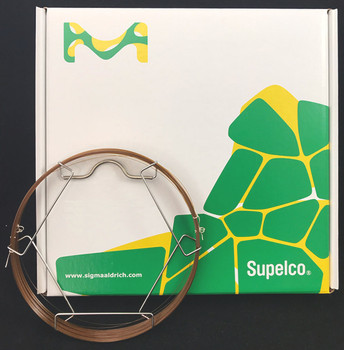Description
Supel-Q PLOT Capillary GC Column
L × I.D. 30 m × 0.32 mm, average thickness 15 μm
Synonym: Supel-Q PLOT Column, 30m x 0.32mm
-
eCl@ss 32119290
Properties
| Related Categories | All Gas Chromatography Columns, Analytical/Chromatography, Capillary GC Columns, Capillary GC Columns, by name, Gas Chromatography (GC), Gas Chromatography columns, Supel-Q PLOT |
| material | fused silica |
| description | PLOT = Porous Layer Open Tubular |
| mfr. no. | Supel-Q |
| parameter | ≤25-250 °C temperature (isothermal or programmed) |
| average thickness | 15 μm |
| df | 15 μm |
| application(s) | gas chromatography (GC): suitable |
| L × I.D. | 30 m × 0.32 mm |
| matrix active group | Divinylbenzene phase |
| Featured Industry | Chemicals and Industrial Polymers Food and Beverages Petroleum |
| column type | capillary PLOT |
General description
Supel-Q™ porous layer open tubular (PLOT) capillary GC column contains divinylbenzene (DVB) polymer, which acts as a stationary phase. It effectively resolves carbon dioxide from the hydrocarbon gases. It is also highly suitable for separating much higher boiling hydrocarbons.[1]
Application: This column exhibits very little bleed, even at its maximum temperature, and effectively resolves carbon dioxide and C1-C4 hydrocarbons at above ambient temperatures. It is also suitable for analyses of sulfur gases, alcohols, ketones, aldehydes, and many polar compounds. Gasoline and other petroleum fractions can be analyzed as well.
USP Code: None
Phase:
• Divinylbenzene
Temp. Limits:
• Subambient to 250 °C (isothermal or programmed)
Application
• Supel-Q PLOT fused silica capillary column was used with headspace SPME-GC, used for analysis of cyanide in blood.[2]
• It may also be used as an extraction device, with SPME coupled with liquid chromatography-tandem mass spectrometry (LC/MS/MS), for the determination of five estrogens, estrone, 17ß-estradiol, estriol, ethynyl estradiol, and diethylstilbestrol in environmental waters.[3]
• It may also be used to separate water from volatile organic compounds (VOCs) in direct aqueous injection-gas chromatography/mass spectrometry (DAI-GC/MS) method, used for trace analysis of VOCs.[4]








